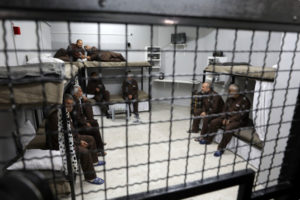Washington, 5 Rabiul Awwal 1434/17 January 2013 (MINA) – Four years after the onset of the global financial crisis, the world economy remains fragile and growth in high-income countries is weak, according to the World Bank report published in www.worldbank.org received by Mi’raj News Agency (MINA), Thursday.
Developing countries need to focus on raising the growth potential of their economies, while strengthening buffers to deal with risks from the Euro Area and fiscal policy in the United States, says the World Bank in the newly-released Global Economic Prospects (GEP) report.
 “The economic recovery remains fragile and uncertain, clouding the prospect for rapid improvement and a return to more robust economic growth,” said World Bank Group President Jim Yong Kim.
“The economic recovery remains fragile and uncertain, clouding the prospect for rapid improvement and a return to more robust economic growth,” said World Bank Group President Jim Yong Kim.
Also Read: UN Urges Respect for Media Freedom after Blinken Protested by Journalists over Gaza
“Developing countries have remained remarkably resilient thus far. But we can’t wait for a return to growth in the high-income countries, so we have to continue to support developing countries in making investments in infrastructure, in health, in education. This will set the stage for the stronger growth that we know that they can achieve in the future.”
Last year developing countries recorded among their slowest economic growth rates of the past decade, partly because of the heightened Euro Area uncertainty in May and June of 2012. Since then, financial market conditions have improved dramatically.
International capital flows to developing countries, which fell 30 percent in the second quarter of 2012, have recovered and bond spreads have declined to below their long-term average levels of around 282 basis points.
Developing-country stock markets are up 12.6 percent since June, while equity markets in high-income countries are up by 10.7 percent. However, the real-side of the economy has responded modestly. Output in developing countries has accelerated, but is being held back by weak investment and industrial activity in advanced economies.
Also Read: Blinken Faces Protests From Journalists over Gaza Genocide
“From hopes for a U-shaped recovery, through a W-shaped one, the prognosis for global growth is getting alphabetically challenged. With governments in high-income countries struggling to make fiscal policies more sustainable, developing countries should resist trying to anticipate every fluctuation in developed countries and, instead, ensure that their fiscal and monetary policies are robust and responsive to domestic conditions,” said Kaushik Basu, Senior Vice President and Chief Economist at The World Bank.
The World Bank estimates global GDP grew 2.3 percent in 2012, compared with last June’s expectation of 2.5 percent. Growth is expected to remain broadly unchanged at 2.4 percent growth in 2013, before gradually strengthening to 3.1 percent in 2014 and 3.3[1] percent in 2015.
 Developing-country GDP is estimated to have grown 5.1 percent in 2012, and is projected to expand by 5.5 percent in 2013, strengthening to 5.7 percent and 5.8 percent in 2014 and 2015, respectively. Growth in high-income countries has been downgraded from earlier forecasts, at 1.3 percent for 2012 and 2013, firming to 2.0 percent in 2014 and 2.3 percent by 2015.
Developing-country GDP is estimated to have grown 5.1 percent in 2012, and is projected to expand by 5.5 percent in 2013, strengthening to 5.7 percent and 5.8 percent in 2014 and 2015, respectively. Growth in high-income countries has been downgraded from earlier forecasts, at 1.3 percent for 2012 and 2013, firming to 2.0 percent in 2014 and 2.3 percent by 2015.
Growth in the Euro Area is now projected to only return to positive territory in 2014, with GDP expected to contract by 0.1 percent in 2013, before edging up to 0.9 percent in 2014 and 1.4 percent in 2015. Overall, global trade of goods and services, which grew only 3.5 percent in 2012, is expected to accelerate, expanding by 6.0 percent in 2013 and 7.0 percent by 2015.
Also Read: Cuba to Join South Africa’s Genocide Case at ICJ against Israel
“The weakness in high-income countries is dampening developing-country growth, but strong domestic demand and growing South-South economic linkages have underpinned developing country resilience – to the point that, for the second year in a row, developing countries were responsible for more than half of global growth in 2012,” said Hans Timmer, Director, Development Prospects Group, the World Bank.
Downside risks to the global economy include: a stalling of progress on the Euro Area crisis, debt and fiscal issues in the United States, the possibility of a sharp slowing of investment in China, and a disruption in global oil supplies. However, the likelihood of these risks and their potential impacts has diminished, and the possibility of a stronger-than-anticipated recovery in high-income countries has increased.
Although fiscal sustainability in most developing countries is not an issue, government deficits and debt are much higher today than in 2007.
“To assure resilience to downside risks, developing countries need to gradually rebuild depleted fiscal and monetary buffers, and improve social safety nets and food security,” said Andrew Burns, Manager of Global Macroeconomics and lead author of the report.
Also Read: US Activists Hold Protest Demanding Release of Medical Workers Detained by Israel
Regional Highlights
Growth outlooks for each country are available in the full report at: www.worldbank.org/globaloutlook
 Growth in the East Asia and Pacific region slowed to an estimated 7.5 percent in 2012, from 8.3 percent in 2011, largely due to weak external demand and policy actions in China to contain inflation. Growth in the region, excluding China, slowed less quickly due to robust domestic demand.
Growth in the East Asia and Pacific region slowed to an estimated 7.5 percent in 2012, from 8.3 percent in 2011, largely due to weak external demand and policy actions in China to contain inflation. Growth in the region, excluding China, slowed less quickly due to robust domestic demand.
Also Read: Death Toll in Los Angeles Wildfires Rises to 16
Economic activity throughout the region accelerated toward the end of the year as global financial markets stabilized and policies in China became more accommodative.
Regional GDP growth is projected to pick up to 7.9 percent in 2013 before stabilizing at around 7.5 percent by 2015, with China’s economy expanding at 8.4 percent in 2013, before easing to 7.9 percent by 2015. Ex-China, regional growth is forecast to average 5.9 percent over 2013-2015 on strong domestic demand and intensified global trade flows.
GDP growth in Europe and Central Asia is estimated to have slowed sharply to 3 percent in 2012 from 5.5 percent in 2011 as the region faced significant headwinds, including weak external demand, deleveraging by European banks, summer drought and commodity-price induced inflationary pressures. Growth slowed most in countries with strong economic linkages to the Euro Area, while it was relatively robust in resource-rich economies that have benefited from high commodity prices.
GDP growth in the region is projected to rebound to 3.6 percent in 2013 and 4.3 percent by 2015. Medium-term prospects for the region will critically depend on progress in addressing external (large current account deficits) and domestic (large fiscal deficit, unemployment, and inflation) imbalances, lack of competitiveness, and structural constraints.
Also Read: Biden Stresses Need for Immediate Ceasefire in Gaza
In the Latin America and the Caribbean region GDP declined to an estimated 3 percent in 2012 (from 4.3 percent in 2011) because of a marked slowdown in domestic demand in some of the largest economies in the region and a weak external environment. Growth in Brazil, the region’s largest economy, expanded only an estimated 0.9 percent in 2012.
A more accommodative policy environment, stronger capital flows (notably FDI) and more robust external demand are expected to lift regional growth over 2013-2015 to an average of 3.8 percent. Labor and tax reforms underway in some of the larger economies, and a drive to boost infrastructure investment should help address some of the structural issues that have constrained growth in the region.
Growth in the Middle East and North Africa region continues to be affected by political uncertainty and unrest in several countries. Regional GDP is estimated to have grown by 3.8 percent in 2012 (following a 2.4 percent decline in 2011), mostly due to a pickup in Libyan oil output and continued robust expansion in Iraq.
Growth among regional oil importers, however, remained sluggish at an estimated 2.5 percent in 2012 (2.4 percent in 2011) due to weak exports and tourism, together with country-specific problems, including a poor harvest in Morocco, fiscal difficulties in Jordan, and continuing uncertainty and weak reserves position in Egypt.
Also Read: Death Toll of Massive Los Angeles Wildfires Rises to 11
Regional GDP growth is projected to slow to 3.4 percent in 2013, rising to 4.3 percent by 2015, assuming an easing of the current uncertainty and domestic unrest, a strengthening of tourism, and a recovery of the region’s exports as global demand continues to firm.
In South Asia, growth weakened to an estimated 5.4 percent in 2012 (7.4 percent in 2011), mainly due to a sharp slowdown in India, where GDP growth (measured at factor cost) is forecast at 5.4 percent in the fiscal year ending March 2013. Weak global demand exacerbated region-specific factors, including subdued investment growth, electricity shortages, policy uncertainties, and a weak monsoon.
Regional GDP is projected to grow by 5.7 percent in the 2013 calendar year, and by 6.4 and 6.7 percent in 2014 and 2015, respectively, driven by policy reforms in India, stronger investment activity, normal agricultural production, and improvement in export demand. Growth in India (at factor cost) is projected at 6.4 percent in the 2013 fiscal year, rising to 7.3 percent by 2015.
Growth in Sub-Saharan Africa remained robust at 4.6 percent in 2012. Excluding South Africa, the region’s largest economy, GDP output expanded 5.8 percent in 2012, with a third of countries in the region growing by at least 6 percent. Robust domestic demand, still high commodity prices, increased export volumes (due to new capacity in the natural resource sector) and steady remittance flows supported growth in 2012.
Also Read: UN Experts Urge US Senate to Oppose ICC Sanctions Bill
However, the expansion was curtailed by domestic factors, including earlier monetary policy tightening (Kenya and Uganda), protracted labor disputes (South Africa), and political unrest (Mali and Guinea Bissau). The region is projected to grow at its pre-crisis average of 5 percent during 2013-15.
Using 2005 purchasing power parity weights, global growth would be 3.0, 3.4 and 4.2 percent for 2012, 2013 and 2015, respectively. (T/R-022/R-006)
Mi’raj News Agency (MINA)
Also Read: Thousands of Homes Destroyed by Los Angeles Wildfires as Authorities Confirm 10 Deaths















 Mina Indonesia
Mina Indonesia Mina Arabic
Mina Arabic Mina Preneur
Mina Preneur